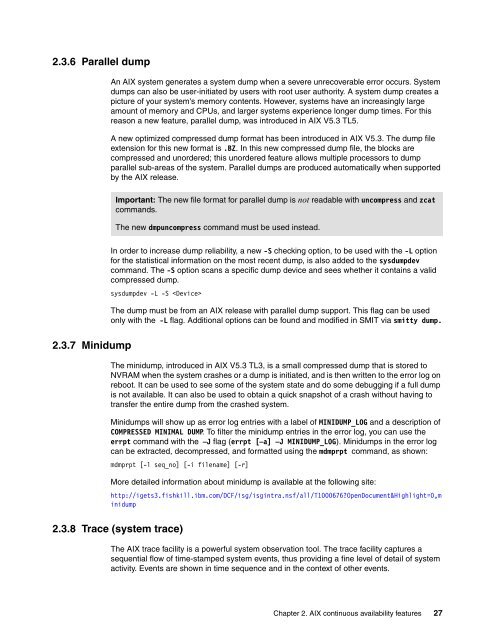IBM AIX Continuous Availability Features - IBM Redbooks
IBM AIX Continuous Availability Features - IBM Redbooks
IBM AIX Continuous Availability Features - IBM Redbooks
You also want an ePaper? Increase the reach of your titles
YUMPU automatically turns print PDFs into web optimized ePapers that Google loves.
2.3.6 Parallel dump<br />
2.3.7 Minidump<br />
An <strong>AIX</strong> system generates a system dump when a severe unrecoverable error occurs. System<br />
dumps can also be user-initiated by users with root user authority. A system dump creates a<br />
picture of your system's memory contents. However, systems have an increasingly large<br />
amount of memory and CPUs, and larger systems experience longer dump times. For this<br />
reason a new feature, parallel dump, was introduced in <strong>AIX</strong> V5.3 TL5.<br />
A new optimized compressed dump format has been introduced in <strong>AIX</strong> V5.3. The dump file<br />
extension for this new format is .BZ. In this new compressed dump file, the blocks are<br />
compressed and unordered; this unordered feature allows multiple processors to dump<br />
parallel sub-areas of the system. Parallel dumps are produced automatically when supported<br />
by the <strong>AIX</strong> release.<br />
Important: The new file format for parallel dump is not readable with uncompress and zcat<br />
commands.<br />
The new dmpuncompress command must be used instead.<br />
In order to increase dump reliability, a new -S checking option, to be used with the -L option<br />
for the statistical information on the most recent dump, is also added to the sysdumpdev<br />
command. The -S option scans a specific dump device and sees whether it contains a valid<br />
compressed dump.<br />
sysdumpdev -L -S <br />
The dump must be from an <strong>AIX</strong> release with parallel dump support. This flag can be used<br />
only with the -L flag. Additional options can be found and modified in SMIT via smitty dump.<br />
The minidump, introduced in <strong>AIX</strong> V5.3 TL3, is a small compressed dump that is stored to<br />
NVRAM when the system crashes or a dump is initiated, and is then written to the error log on<br />
reboot. It can be used to see some of the system state and do some debugging if a full dump<br />
is not available. It can also be used to obtain a quick snapshot of a crash without having to<br />
transfer the entire dump from the crashed system.<br />
Minidumps will show up as error log entries with a label of MINIDUMP_LOG and a description of<br />
COMPRESSED MINIMAL DUMP. To filter the minidump entries in the error log, you can use the<br />
errpt command with the –J flag (errpt [–a] –J MINIDUMP_LOG). Minidumps in the error log<br />
can be extracted, decompressed, and formatted using the mdmprpt command, as shown:<br />
mdmprpt [-l seq_no] [-i filename] [-r]<br />
More detailed information about minidump is available at the following site:<br />
http://igets3.fishkill.ibm.com/DCF/isg/isgintra.nsf/all/T1000676?OpenDocument&Highlight=0,m<br />
inidump<br />
2.3.8 Trace (system trace)<br />
The <strong>AIX</strong> trace facility is a powerful system observation tool. The trace facility captures a<br />
sequential flow of time-stamped system events, thus providing a fine level of detail of system<br />
activity. Events are shown in time sequence and in the context of other events.<br />
Chapter 2. <strong>AIX</strong> continuous availability features 27

















